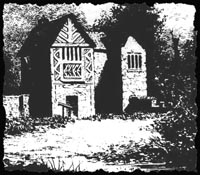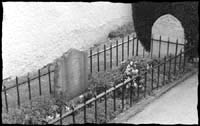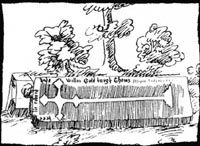|
in search of... The popular story of Robin Hood immortalized by Hollywood myth is based on a play written by Shakespeare’s contemporary Anthony Munday in 1598. It tells the tale of a disinherited nobleman who leads a band of outlaws in their fight against the ruthless Sheriff of Nottingham from the depths of Sherwood Forest. The story is set in the 1190s when King Richard I is away fighting in the crusades and his brother Prince John is left to rule England in his place. Most historians who had previously searched for evidence of historical truth behind the story examined records from the reign of Richard I. As nothing conclusive was found, many believe that Robin Hood was nothing more than a myth. However, in his historical research, renowned historical writer Graham Phillips uncovered conclusive evidence of an historical Robin Hood from an entirely different period. The reason others had failed to discover this elusive documentation is that, based on mistakes made by Anthony Munday, they had been researching the wrong dates. In the vaults of the British Library in London, there survives a tale of Robin Hood written 200 years before Anthony Munday’s time. It is an anonymous work that first appeared in the mid-to-late 1300s called The Gest of Robin Hood. The word Gest was a medieval word meaning a story or tale so, for convenience, the work is referred to as the Gest. Literary scholars had long known of the Gest’s, existence, but many historians overlooked its importance as evidence for an historical Robin Hood. Significantly, it places the story in a different time to Munday’s play. It is set in the early fourteenth century and not the late twelfth, and the king is not Richard I but Edward II. Neither is Robin a nobleman, but a soldier – a knight in the army of Thomas, the Earl of Lancaster. The action takes place in 1322 when Robin is forced to become an outlaw after the Earl of Lancaster leads a failed rebellion against the king. Lancaster’s rebellion was an historical event and the records show that many of his defeated followers did flee into Sherwood Forest to continue a guerrilla campaign. The Earl of Lancaster had been the lord of both Nottinghamshire and Yorkshire, and had led a popular uprising against unfair taxes imposed by the king, following a crippling famine. Unfortunately, Lancaster was betrayed when his plans were revealed to the king by his trusted deputy, Henry de Facombery. When the rebel army was defeated at the battle of Boroughbridge in Yorkshire on 15 March 1322, Lancaster was killed and the king rewarded Facombery by appointing him sheriff of Nottinghamshire and Yorkshire. He was charged with rounding up the rebels who had fled south into Sherwood Forest. Henry de Facombery, it seems, became the fabled Sheriff of Nottingham. Following the work of an obscure mid-nineteenth-century Yorkshire historian named Joseph Hunter, Graham discovered a record of the leader of the rebels who had escaped following Lancaster defeat. In the archives of Wakefield Manor on the northern edge of Barnsdale Forest, just to the north of Sherwood, his name is recorded as "Robert Hode". As Robin was a nickname for Robert and Hode was a medieval spelling of Hood, it seemed that the historical Robin Hood had at last been found. In fact, in one particular document he is actually referred to as ‘Robin Hode’ The possibility that Robert Hode was indeed the historical Robin Hood was supported by the names of other outlaws recorded as being in his band. For example, a man who went by the name of Little John is recorded as being buried in nearby Hathersage churchyard, where his grave can still be seen, and a Friar Tuck is recorded as Lancaster’s chaplain who took part in the revolt. Robert’s wife was even a perfect candidate for Maid Marian. Remarkably for the time, Robert’s wife actually joined him in the forest and played an active part in the struggle. Both this and her name provided further confirmation that Robert Hode was the historical Robin Hood. Robert was a relatively wealthy knight who lived in modest manor on the edge of Barnsdale Forest in the village of Bichill, a few miles south of Wakefield. In 1321 he married a girl from the nearby village of Woolley named Matilda. In Anthony Munday’s play Matilda had been Maid Marian’s real name, the name Marian being an alias she adopted once she had fled into Sherwood Forest. Just as in legend, Matilda Hode joined her husband in the forest and, remarkably for the time, had actually played an active part in the struggle. All this provided astonishing confirmation that Robert Hode was indeed the historical Robin Hood. The royal archives, dating from the reign of Edward II at Winchester in southern England, reveal that the Sherwood outlaws were eventually granted an amnesty by the king in 1323, in return for their support in putting down a new rebellion. Two years later, with the rebellion behind him, Edward had a change of heart. Robert and his followers were once again outlawed and disappear from record. Graham could find no historical evidence of what became of Robert Hode. However, the Gest says that Robin Hood was eventually murdered - poisoned by the abbess of Kirklees Priory in Yorkshire when he sought sanctuary there in 1347. Why the abbess killed him is a mystery as the surviving manuscript is damaged and the verses pertaining to the betrayal no longer survive. All we learn is that, after killing Robin, the abbess took her own life and Little John arrived to bury his friend’s body nearby. Kirklees Priory historically existed and Elizabeth de Staynton is actually recorded as abbess in the 1340s. When her grave was found in the 1950s, the inscription revealed that she had indeed died in 1347, the very year the Gest says she took her own life. More remarkably, the grave of a Robert Hode was discovered in a woodland nearby. The original is no longer there but in 1665 a local historian named Nathaniel Johnston made a drawing of it and that still survives. Today a crumbling nineteenth-century monument marks the spot, bearing an inscription that claims it to be the actual site of Robin Hoods' grave.
|



